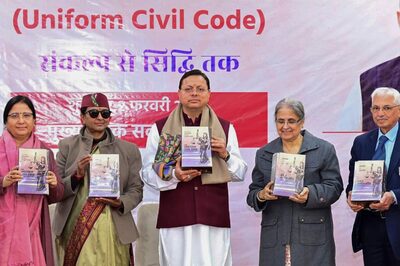
views
Patna/Karmatand: Karmatand, a sleepy hamlet of Jamtara in Jharkhand, is avid with debates and discussions on why and who broke the statue of the noted social reformer Ishwar Chandra Vidyasagar on a college campus in Kolkata.
The people of Karmatand are agitated because Vidyasagar had chosen this place as his second home in 1873 and spent nearly two decades of his life in this sleepy village situated on the Bihar (now Jharkhand)-West Bengal border. He had set up a girls’ school and a night school for the adults on the premises of his house, which he named as Nandan Kanan.
The sacrilege committed by the anti-social elements by desecrating the statue on the campus of Vidyasagar College has led to a political battle between the resurgent BJP and the aggressive Trinamool Congress in West Bengal just before the last leg of the elections. Prime Minister Narendra Modi has accused the Trinamool Congress workers for vandalising the bust of Vidyasagar and promised to install a grand statue at the same spot.
For the people of Karmatand and ardent followers of Vidyasagar, the incident reflects dismantling of the progressive Bengali culture pursued by political outfits fighting for political space and their survival in West Bengal.
“It is sort of blasphemy and we are shocked by the act. The Bengalee Association of Bihar expresses its anguish and demands impartial inquiry into the matter,” said Dr (Captain) Dilip Kumar Sinha, the president of the Bihar Bengalee Association and vice-chairman of the Vidyasagar Smrity Raksha Committee, which owns and manages the house built by Vidyasagar at Karmatand in Jamtara district of Jharkhand.
In view of the escalating tension in Kolkata in particular and West Bengal in general, the Jharkhand government, as a precautionary measure, has tightened security around Nandan Kanan — the house of Vidyasagar in Karmatand.
The long association of Ishwar Chandra Vidyasagar with Karmatand had gone into oblivion and people had forgotten that the great Bengali renaissance leader lived here till the Bihar-Bengalee Association searched it and purchased the house in 1974 by paying Rs 24,000 to its then owners.
The purpose was to repay the debt of the ‘Guru’, as Vidyasagar was reverently called, and save the sprawling Nandan Kanan spread over 3 acres and 19 decimal of land. The Bihar-Bengalee Association collected funds for its purchase by selling one rupee coupons. The then chief minister of Bihar, Abdul Ghafoor, had graciously donated Rs 15,000 for the purpose.
Subsequently, the Bihar-Bengalee Association formed Vidyasagar Smrity Raksha Committee with noted litterateur Bibhuti Bhushan Mukhopadhyay as its president. The committee established Vidyasagar Balika Vidyalaya, which was recognised by the then Bihar government as an unaided minority school.
Unfortunately, the school was closed nearly eight years ago due to lack of funds. However, a separate guest house has been constructed on the campus from the local area development fund of JMM leader Shibu Soren.
It was after persistent efforts of the Bihar-Bengalee Association for years together that the Karmatand railway station was christened as Vidyasagar railway station by the Railway Ministry following a recommendation from the Bihar government.
In 1993, a marble bust of Vidyasagar was laid on an erected pedestal at the place where Vidyasagar used to sit in the evenings. The bust was installed by noted advocate of the Patna High Court late Shyama Prasad Mukherjee and unveiled by the then Chief Justice of the Patna High Court, Bimal Chandra Basak.
Vidyasagar was venerated as God by the people of Karmatand, who still worship the cemented dais marking the spot where Vidyasagar sat and met people every day. Since 2011, the Bengali Association organises ‘Smriti Tarpan’ programme named ‘Guru Dakshina’ every year on March 29, the day Bengalee Association acquired the property.
As Vidyasagar learnt and practiced homeopathy to treat the local Santhal tribals, the Vidyasagar Smrity Raksha Committee has set up ‘Vidyasagar Databya Homeopathic Chikitsalaya’ with the financial assistance of Chameli Chatterjee of Jamshedpur.
Chief Minister of Jharkhand Raghubar Das has also announced to develop Nandan Kanan as heritage site. It is learnt the Circle Officer of Karmatand has already submitted a DPR to develop Nandan Kanan as a heritage site and develop it as a tourist place.
The Vidyasagar Smrity Raksha Committee has renovated the house, which was in a dilapidated condition when the Bihar-Bengalee Association purchased it. The wooden cot, on which Vidyasagar used to sleep, has been kept in one of the rooms of the seven-room building while the other rooms have been painted with life-sketches of Vidyasagar.
However, a portion of the building is still occupied by one Mohan Mandal, who claimed that his great grandfather Kartik Mandal served Vidyasagar. But members of the Vidyasagar Smrity Raksha Committee claimed that one Adhiram Mandal used to assist Vidyasagar and looked after his charitable work. Before the house was identified and refurbished, the local wing of the RSS used the ground for their daily shakha drills.
Vidyasagar, who developed Bengali language and grammar, had waged a sustained battle for the abolition of child marriage and advocated widow re-marriage. His sustained struggle forced the then East India Company administration to frame rules allowing widow re-marriage.
After the death of Vidyasagar, his only son Narayanchandra sold the house to a businessman, who used the land for rose cultivation. It is said the roses grown here were exported to European countries. However, the Nandan Kanan house with the sprawling campus was later sold to one Singhdas Mallick. The Bihar-Bengalee Association purchased it from Singhdas’ sons – Birendra Nath Mallick and Jitendra Nath Mallick.
The Nandan Kanan eagerly awaits approval of the Jharkhand or the central government for upgrading it as a heritage site before its legacy is infringed upon by unwanted elements sponsored by political outfits to settle political score with each other like the unfortunate Kolkata incident.
(The author is a senior journalist)




















Comments
0 comment